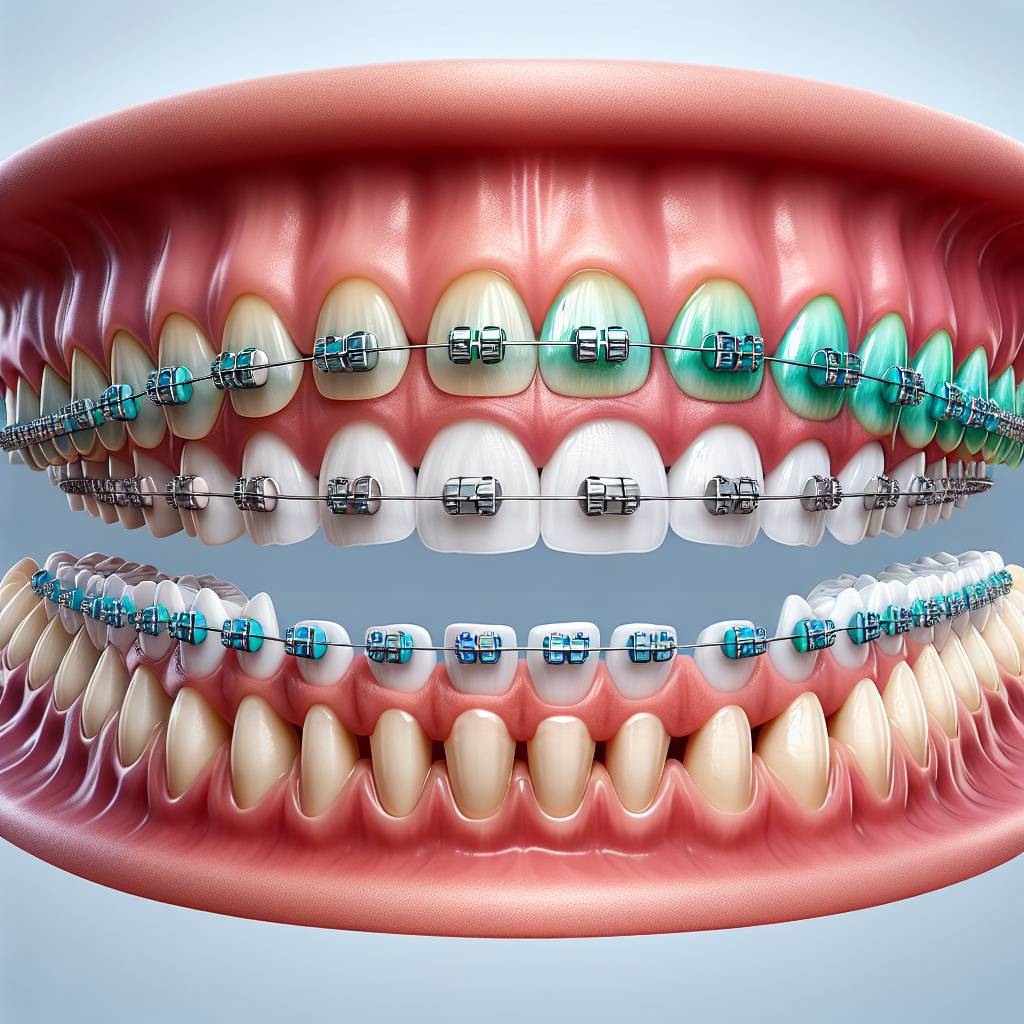Aligning teeth is a process that can take a few months to a couple of years, depending on the severity of the misalignment and the desired outcome. Orthodontic professionals use braces, clear aligners, and other appliances to correct crooked teeth and improve overall oral health. The duration of treatment varies from person to person, but in general, it can take anywhere from six months to two years for your teeth to be fully aligned. In most cases, the earlier treatment begins, the shorter the time it will take for treatment to be completed.The length of time it takes to align teeth will depend on the individual and the severity of their misalignment. Generally, orthodontic treatment ranges from 6 months to 2 years. However, more complex cases may take longer.
Improving Oral Health
One of the main reasons to align your teeth is to improve your oral health. When teeth are not aligned properly, it can be difficult to clean them properly, which can lead to a buildup of plaque and tartar. This can increase the risk of gum disease and cavities, which can cause pain and discomfort. Teeth alignment can help ensure that all areas of the mouth are easy to reach with a toothbrush or floss, reducing the chances of developing these dental problems.
Improving Appearance
Another reason for teeth alignment is improving one’s appearance. Crooked or misaligned teeth can make a person feel self-conscious when smiling or speaking in public, as well as having an impact on their overall confidence. Teeth alignment helps to create a more aesthetically pleasing smile by straightening the teeth, which can boost someone’s self-esteem significantly.
Preventing Jaw Problems
Having misaligned teeth can also lead to jaw problems such as TMJ disorder (temporomandibular joint disorder). This condition causes pain and discomfort in the jaw joints and muscles, and it is often caused by excessive stress on the jaw due to uneven bite pressure from crooked or misaligned teeth. By straightening your teeth with an orthodontic treatment such as braces or Invisalign, you can help prevent this condition from occurring in the first place.
Preventing Tooth Damage
Misaligned teeth are also more susceptible to damage caused by clenching and grinding because they are more likely to have uneven contact points when biting down. By correcting these contact points with orthodontic treatment, you can reduce the chances of damaging your teeth over time due to grinding or clenching.
Types of Teeth Alignment Procedures
Teeth alignment procedures are used to improve the appearance of crooked, misaligned, or overcrowded teeth. It is important to understand the various types of teeth alignment procedures available so that you can make an informed decision about which procedure is best for your individual needs. Some of the most common types of teeth alignment treatments include traditional braces, clear aligners, and removable aligners.
Traditional braces use metal brackets and wires to move teeth into their desired positions. The brackets are bonded to the front surfaces of the teeth and then connected by a wire. The brackets are then tightened and adjusted periodically in order to move the teeth into their desired positions. Traditional braces can be used to correct a variety of issues, including gaps between teeth, overbites, underbites, and overcrowding.
Clear aligners are also an option for those seeking an alternative to traditional braces. Clear aligners are made from a clear plastic material that fits snugly over your teeth like a glove and is virtually invisible when worn. Clear aligners gradually move the teeth into their desired positions using a series of trays that fit over the teeth and need to be replaced every two weeks or so as they become loose-fitting due to the shifting of the teeth underneath them.
Removable aligners are another option for those looking for an alternative to traditional braces or clear aligners. These devices resemble mouth guards and fit snugly over your top and bottom sets of teeth. As with other options, removable aligners gradually shift your teeth into position by applying pressure on certain areas throughout treatment. Removable aligners have the added benefit of being able to be taken out when eating or brushing your teeth, making them more convenient than traditional braces or clear aligners in some cases.
No matter what type of tooth alignment procedure you choose, it is important to discuss all options with your dentist in order to determine which one is best for your individual needs and goals regarding your oral health.
What Is The Average Treatment Time for Teeth Alignment?
The average treatment time for teeth alignment depends on the type of orthodontic treatment being used. In general, braces typically require 18-24 months of treatment, although the exact amount of time can vary depending on the severity of the misalignment. For more minor cases, such as minor crowding or spacing issues, clear aligners may be used and take 6-18 months to move teeth into desired positions.
For adults seeking alignment to correct mild misalignments, clear aligners may be the best option as they are virtually invisible and don’t require the same level of care and maintenance as braces. Clear aligners are also typically faster to complete treatment than traditional braces with most adults completing treatment within one year.
Invisalign is a popular type of clear aligner that is known for its comfortable fit and ease of use. Invisalign works by gradually straightening teeth using a series of custom-made trays that are changed out every two weeks until the desired results are achieved. Most adults complete their Invisalign treatments within a year with some cases taking as little as six months to reach completion.
No matter which type of orthodontic treatment you choose, it’s important to follow your orthodontist’s instructions closely in order to achieve optimal results in the shortest amount of time possible. Regular checkups with your orthodontist will help ensure that your treatment is progressing as planned and allow them to make any necessary adjustments along the way if needed.
Cost of Teeth Alignment Procedures
The cost of teeth alignment procedures varies depending on the type of procedure and the extent of the teeth misalignment. Generally, braces or aligners are used to fix misaligned teeth. Braces can range from $3,000 to $7,000; while aligners could cost anywhere from $1,500 to $8,000. Additionally, some orthodontists may offer discounts or payment plans to help manage the costs. In some cases, insurance may cover part of the cost; however this will depend on the insurance plan.
Invisalign is a popular choice for adults looking for an alternative to traditional braces. This procedure uses clear plastic aligners that are custom-fitted for each patient’s mouth and gradually move the teeth into place over time. The cost of Invisalign usually ranges from $4,000 to $8,000 depending on the complexity of the case and how long it takes for treatment to be completed.
It is important to find an orthodontist who is experienced in providing teeth alignment procedures that fits within your budget. Many orthodontists offer free consultations so you can discuss your options and get an estimate for treatment costs before committing to any procedure.

The Benefits of Teeth Alignment
Straightening your teeth with braces or other orthodontic treatments has many benefits. Not only does it improve the aesthetics of your smile, it also helps you to maintain good oral hygiene. Teeth alignment can also reduce the risk of tooth decay and gum disease, as well as improve overall comfort and bite function. Here are some of the benefits that come with straightening your teeth:
Improved Aesthetics: Straight teeth are more aesthetically pleasing than crooked or misaligned teeth. Orthodontic treatment can help you achieve a more balanced and symmetrical smile which can boost your confidence when talking or smiling in public.
Better Oral Hygiene: It is easier to keep straight teeth clean than crooked ones as food particles are less likely to get stuck in between them. This reduces the risk of tooth decay and gum disease, as well as bad breath which is often caused by a build-up of bacteria in the mouth.
Improved Comfort: Crooked teeth can cause pain or discomfort when eating or talking due to uneven pressure on the jaw joints and muscles. Straightening your teeth helps to alleviate this discomfort and makes it easier for you to speak and chew without pain.
Better Bite Function: Misaligned teeth can affect how your upper and lower jaws meet together, leading to problems with biting and chewing. Orthodontic treatment helps you achieve a better bite by realigning your top and bottom teeth so that they fit together properly when you close your mouth.
Preparing for Teeth Alignment Procedure
Preparing for a teeth alignment procedure is an important part of the process. It ensures that the procedure is as successful and comfortable as possible. Your dentist will provide you with detailed instructions on how to prepare for the procedure, so make sure you read and follow all the instructions carefully. Here are some of the key things to keep in mind when preparing for a teeth alignment procedure:
It’s important to brush and floss your teeth before the procedure. This will help ensure that your teeth are clean and free of debris so that your orthodontist can properly align them. It’s also important to avoid eating or drinking anything up to eight hours before the procedure. This will help prevent any food particles from getting stuck between your teeth during the alignment process.
Your orthodontist may also ask you to wear certain clothing for the procedure, such as loose-fitting clothes or a lab coat. Wearing these items can help make it easier for your orthodontist to access your teeth during the alignment process.
Before beginning any type of dental treatment, it’s important to discuss any allergies or medical conditions you may have with your orthodontist. This will help ensure that they can create a safe environment for you during your treatment and avoid any potential complications due to allergies or medical conditions.
Finally, it’s important to arrange transportation home after the procedure is completed. You may be feeling lightheaded or dizzy after undergoing a teeth alignment procedure, so it’s best to be sure you have someone available who can take you home safely afterwards.
By following these guidelines and taking care of yourself before and after a teeth alignment procedure, you can ensure that the process goes as smoothly as possible and that you get optimal results from your treatment!
Aftercare Instructions for Teeth Alignment Procedure
It is important to take good care of your teeth after an alignment procedure. Proper aftercare is essential to ensure that the alignment process is successful and long-lasting. Here are some tips to help you take care of your teeth and maintain your new smile:
1. Brush your teeth at least twice a day using fluoride toothpaste. Make sure that you clean all surfaces of your teeth, including the area between each tooth.
2. Floss at least once a day to remove particles of food that are stuck between your teeth. This will help prevent plaque buildup and cavities while also maintaining proper dental health.
3. Avoid eating hard or crunchy foods like candy or chips as these can damage the alignment brackets or wires of your braces and slow down the treatment progress.
4. Chew with your back molars instead of the front ones as this will help prevent damage to the brackets and wires during meals.
5. Visit your dentist regularly for checkups and adjustments to ensure that everything is progressing correctly with your treatment plan.
6. Wear any rubber bands, headgear, or other appliances as prescribed by your orthodontist in order to maintain proper alignment throughout the duration of treatment
By following these simple steps, you can ensure that you get the most out of your teeth alignment procedure and maintain a beautiful smile for years to come!

Conclusion
The process of aligning teeth is a gradual one that depends on the individual case. The length of time it takes to align teeth can vary from a few months to a few years, depending on the severity of the case. Invisalign and other similar clear braces are usually faster than traditional braces, but it ultimately depends on how much movement is needed in order to achieve the desired results. It is important to consult with your orthodontist concerning how long your treatment will take and what methods they recommend.
No matter how long it may take, it is worth investing in orthodontic treatment in order to improve your dental health and enhance the appearance of your smile. Aligning teeth can improve both your oral health and your overall wellbeing, making it worth the wait in the end.

